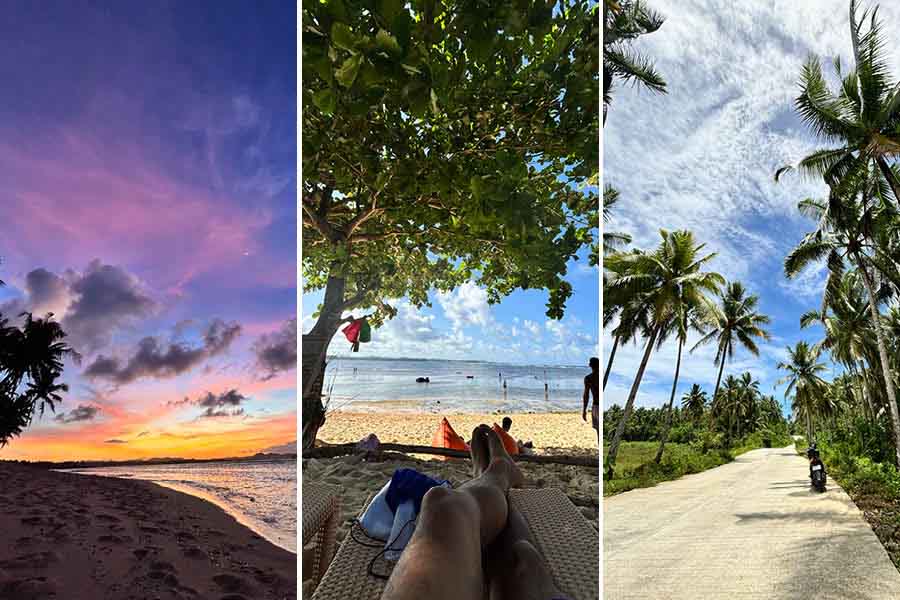The intricate backwater channels weaving through mangrove forests caught my eye as my ATR aircraft prepared to land at Siargao’s very Bengali-sounding Sayak airport.
Siargao is not the first place that people choose when visiting the Philippines for the first time, unless of course one is into surfing. The island, one of the 7,000-odd ones that are part of the archipelago country, has great surfing spots and every other rented motorcycle has surfboard carriers attached to it.
The island is quite large and a 45-minute ride in a shared van took me to Santa Fe National High School, where my host Leo picked me up. A five-minute bumpy ride from the main road on a ‘sidecar’ — a popular mode of transportation made of a carriage attached to a motorcycle — took me to my homestay, which is run by Leo and his partner Lily.
It’s an island of friendly and helpful people and terrible internet, I found out soon. A major typhoon in December 2021 had damaged most communications infrastructure in Siargao and since then mobile phone internet is patchy at best. For more consistent internet, people rely on Starlink, the direct-from-satellite internet service that is costly to install, and hence not readily available everywhere.
My month-long stay cost me less than Rs 50,000, and the space was good for three people. Most Airbnb hosts give you a discount if you book for a month, and this was the discounted price I got.
Families occasionally rent an autorickshaw or a car to move around. I would recommend a two-wheeler because most roads on the island have very little traffic and a motorcycle ride is a dream amid the lush green surroundings. Proper fuel stations are few and far between. But at a premium, you can always fuel up from the many ‘portable’ fuel stations. The price difference could be around PHP 10, which translates to more than Rs 18 per litre.
The island has as many as nine municipalities, my host Lily told me. But the crowded main tourist town is General Luna. If you like it lively and crowded with loads of partying every night, definitely stay there. But for those intending to stay for a couple of weeks or longer — and if you’re planning to base yourself somewhere and not move around — I would recommend somewhere not too far, but outside of the town, which locals refer to as ‘GL’.
Siargao is expensive, even compared to the major city Cebu, some Filipinos told me. The tourism explosion over the past couple of years, coupled with the fact that most goods needed to be brought in by boat, have increased prices. This has resulted in the sad reality of even locals paying the high tourist prices.
The most popular surfing spot on the island is a resort called Cloud 9 in General Luna. I do not surf, but people who do tell me that Santa Fe (you can access the waves via a surf resort called Ocean 9, or on your own) is better in the sense that it is less rocky, so safer. Many beaches across the island are barricaded in such a way that you would need to enter through one particular gate and usually pay a small entrance fee. I suppose that helps maintain the beaches, but occasionally it just feels like a scam to have to pay to enter a beach! A surfing lesson costs PHP 500 (Rs 720) for an hour, but everyone does at least a two-hour session at one go, so each outing on the waves will cost you PHP 1,000 (Rs 1,450 approx).
Just like Bengalis, Filipinos eat a lot of rice with their protein dishes such as adobo, sinigang and sisig. At Siargao, expect to spend PHP 500 for a meal at a mid-range restaurant, without alcohol. You can, of course, get it cheaper from elsewhere if you are on a budget.
The island’s economy is largely cash-based. They do have G-Cash, which works the same way as UPI in India, but you need a Filipino bank account for that. I only found a single large departmental store on the island called Pure Gold that accepted credit cards. Packaged food and alcohol are cheaper at this store, but I found fresh fruits and vegetables more expensive than in the markets.
Most beaches are rocky and the only time you find some sandy beaches is during high tide, because the rocks are hidden underwater. But even in the rocks, there are shallow pools that provide excellent swimming/splashing and chilling environs. However, the experience is not like the wavy encounters with the sea you might be more familiar with.
I am not the touristy kind. I enjoy the idea of going somewhere new and living there more than ticking off a checklist of things to do there. During my month-long stay at Siargao, I went to the local beach often, but there were occasions when I didn’t leave my stay for two days — just slept in, read and worked on my next book. I usually went to the Catangnan Bridge, locally known as the Afam Bridge, at night, when it was empty and rarely during sunset where there’s a daily ‘mela’ taking place with lots of food kiosks, people skateboarding, and just hanging out. To be honest, I found my local beach at Santa Fe offering better sunset views than the bridge. I also managed to try some local dishes, and even managed an invite to the house of a local person where I had some very tasty pork adobo and ‘sinabaw na baboy’ (pork soup) with rice.
For those interested in activities, there are plenty. You could do boat rides through the mangrove backwaters, try your hand at pottery or even betting on cockfights, which is extremely popular and legal in Siargao.
